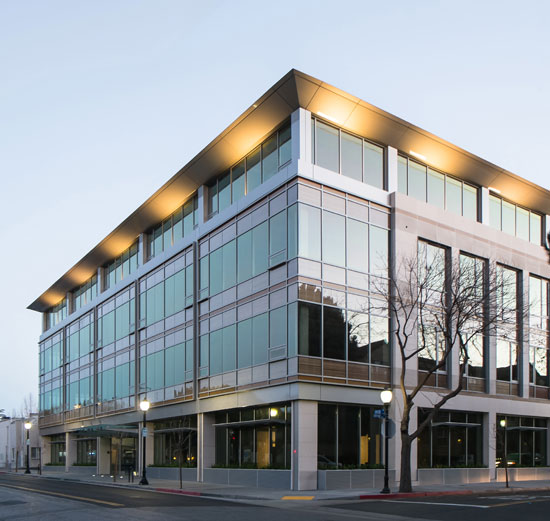Less Is More with Lightweight Honeycomb Reinforced Stone and Porcelain Panels
Engineered panel systems use real stone or porcelain and produce less weight, less labor, less environmental impact, and less cost creating more attractive design solutions.
![]() Continuing Education
Continuing Education
Use the following learning objectives to focus your study while reading this month’s Continuing Education article.
Learning Objectives - After reading this article, you will be able to:
- Identify and recognize the characteristics of lightweight honeycomb reinforced stone wall panels and systems.
- Define and describe the environmentally conscious, sustainable components of lightweight natural stone and porcelain veneer panel systems.
- Assess the functional contributions of reinforced stone walls as they contribute to green and sustainable design as measured by national rating systems.
- Specify reinforced stone walls in a variety of green and conventional buildings and formulate appropriate selections related to specific applications.
Stone has been used on buildings for centuries. It is a natural material that is long lasting and fairly well understood by people who work with it. There are varieties of colors, types, textures, and patterns that exude a variety of design results. In modern buildings though, its primary drawback for use has been its weight. However, architects looking for ways to incorporate stone into current projects can no longer dismiss stone as “too heavy” or too costly. There is now a lighter, much more affordable, sustainable, and proven option—lightweight honeycomb reinforced stone panels.
Stone and Buildings
Stone offers a good deal of versatility and durability in both interior and exterior wall applications. Sometimes it is used as a structural material and other times as infill between other structural components. When considering its use on buildings, architects can compare at least three primary options discussed as follows:
Dimension Stone
According to the U.S. Geological Survey (USGS) dimension stone is defined as natural rock material that is quarried for the purpose of obtaining blocks or slabs for use in buildings or elsewhere. Although a variety of igneous, metamorphic, and sedimentary rocks can be classified as dimension stone, the principal rock types that are quarried for building use include granite, limestone, and travertine which are most common for exterior uses. Additionally, marble, onyx, sandstone, and slate, which are softer stones by nature, are commonly quarried and used for interior applications.
The selection of specific dimension stone is often based on visual requirements of color, grain texture, pattern, and the ability of a stone to be polished to the desired surface finish. From a performance standpoint, selection is also based on the durability of a particular stone which can be assessed based on the mineral composition and hardness of the stone. There is plenty of history on past performance of most quarried stone so it is relatively easy to determine strength and suitability for a particular project. In order to blend into the design of a building project, the quarried blocks or slabs are fabricated by being cut into standard or custom shapes in specific sizes including width, length, and thickness.
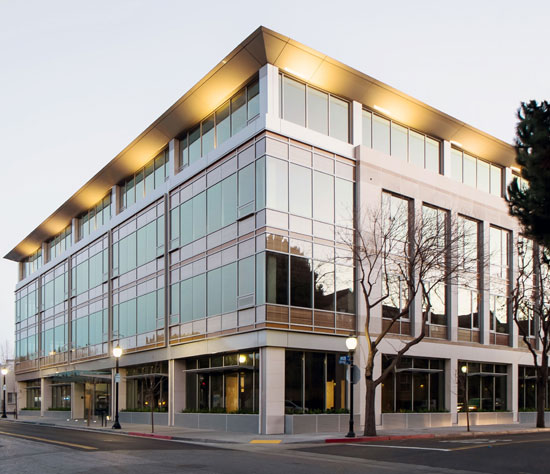
Photo courtesy of TerraCORE Panels, LLC
Lightweight honeycomb reinforced stone panels make it possible to achieve the appeal of stone wall panels without the drawbacks of heavier solid dimension stone.
The most common challenge associated with dimension stone is addressing its weight. This is obvious in the mining and rough cutting of the stone, but it becomes even more significant after leaving the quarry. Transporting large, heavy, multiple pieces of stone means that it is more costly to move from the quarry to the fabrication site, and then to the job site, resulting in a significant amount of embedded energy in the final products. This weight ripples through the rest of the building, particularly if it is used for exterior or interior wall panels, since the structure supporting the stone needs to be beefed up to handle the added dead load of the dimension stone. Installation of heavy stone panels requires appropriate equipment and skilled labor to assure a proper and durable end result. All of this impacts the cost and time required to use dimension stone on buildings. It also offsets some of the environmentally appealing aspects of using a natural material by increasing the impact of its use over its life cycle.
Lightweight Stone Panels
How can the attractive and desirable benefits of stone be retained while overcoming the limitations and challenges of dimension stone? The answer lies in innovations made by manufacturers to produce lightweight stone panels.
The process of fabricating lightweight panels begins with the same quarried stone blocks and slabs with the same benefits and choices of dimension stone. However, once delivered to the manufacturer, the process changes. It is based on using a thin layer of stone that is backed with a lightweight honeycomb layer to reinforce the stone and keep it strong enough to use on a building. The honeycomb is made of fiberglass and/or recycled aluminum with superior performance and strength. In addition to the inherent strength of the honeycomb reinforcing, it also allows for some flexibility and absorption of building stresses that might otherwise cause damage to dimension stone. Because of this composite type of fabrication, the amount of stone is reduced, meaning that the weight is dramatically reduced, such that a single stone block can be used for two or three times the amount of wall panels compared to full-depth dimension stone panels.
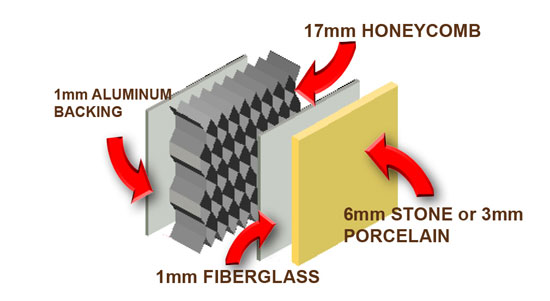
Image courtesy of TerraCORE Panels, LLC
Honeycomb reinforcing can be used behind a full range of stone types to create a lightweight, durable system.
Many natural stone choices can be used for lightweight panels with multiple finish options available, including polished, honed, flamed, bush hammered, sandblasted, antiqued, and acid washed. The specific type of stone selected often affects the manufacturing process. Harder stones like granite can be sliced to a rather thin slab of 7 mm (approximately 3/8 inch) thickness and are finished to their desired appearance. They are then adhered directly to the honeycomb reinforcing with epoxy. Once cured, the panels are cut to their exact finished size and the edges are finished and treated. Softer stones like marble and limestone start with an unfinished slab of conventional thickness. The honeycomb reinforcing is then applied to not one, but both sides of the slab. Now fully reinforced, the stone is split down the middle so two separate panels are created, each with a stone face that is half the thickness that it started with. The panels are then cut to their finished size, and the faces and edges are finished as desired or specified.
When it comes to producing multiple panels, some manufacturers will simply take full-sized dimensioned slabs, add honeycombs, and then cut the panels out of the slabs which can generate significant waste or unused product depending on the panel sizes needed. In order to maximize the yield of the stone, minimize waste, and reduce environmental impacts, other manufacturers look more carefully at the panel sizes compared to the slab sizes. By planning out the cutting patterns ahead of time, the dimensional slabs and the honeycombs are cut first to a rough shape that may be an inch or two larger all around. Then they are precisely cut to final sizes as called for by the architectural design with the edges and faces finished according to specifications. In this way, the yield from each slab can be maximized and the use of the honeycomb reinforcing can be kept very efficient. Each panel is numbered to equate to its location on a building elevation or wall, particularly since different sizes may be needed to accommodate a particular design.
The final step in the manufacturing process is to prepare the panels for installation. Most manufacturers of panels also manufacture their own system for installing them. Typically this involves an aluminum interlocking clip or track system that allows the panels to hang securely on the building wall system. Hence, the appropriate clips or channel pieces are precisely secured onto the back of the panels in the factory. The complementary rail pieces that are intended to be field installed are also fabricated and shipped along with the panels. Once complete, the panels and installation system are crated and packaged to be shipped to the building location. They are organized in crates according to the requirements for installation on each building elevation with each crate numbered just as the panels are according to their final design location.
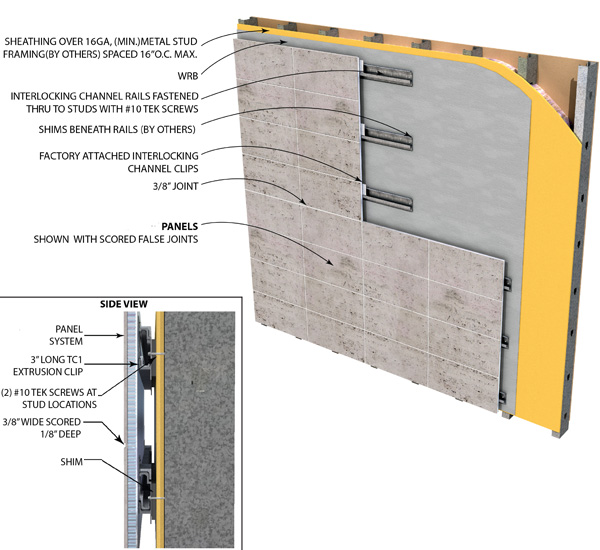
Image courtesy of TerraCORE Panels, LLC
A clip system can be used to install the panels to a wall assembly with clips attached during fabrication and channels attached in the field.
The results of this innovative process include a building that has the visual and performance characteristics of stone with up to 80 percent less weight compared to dimensional stone. This means that the panels can be readily hung on 16-gauge metal stud walls thus keeping structural costs low by keeping the building more lightweight. The manufacturing process of creating permanently bonded panel assemblies’ means there is little worry of warping, expanding or contracting like many heavier stones. They can also be fabricated in a full range of custom or standard sizes up to 4 feet by 8 feet (common stone slab size) or sometimes even larger. When it comes to installation, the lightweight panels have been found to be 5 to 10 times faster to install than solid heavy dimensional stone, thus saving construction time and reducing labor costs. Most of these savings come from the engineered clip or channel system that is installed in the factory and allows for a very efficient installation process. Overall, the final lightweight reinforced panel products are highly tested and fully warranted by manufacturers as a result. Further, in the event that other stone products are needed to complement the design of a building it is possible to specify a full line of diverse dimensional stone products often from the same manufacturer to match the lightweight panels.
Porcelain Panels (Large format)
A variation on incorporating lightweight reinforced panels into a building design is to use panels with large-format manufactured porcelain instead of cut stone. Porcelain is a well-known building product often used for wall or floor tile. It is similar to clay-based ceramic tile, but in fact it is made with different materials that make it denser, more durable, and much less water absorptive. It is manufactured from natural raw materials that include kaolin, silica sand, and feldspars that create these distinctive performance qualities. These materials are atomized, mixed in a press, and fired in a kiln at 2,100 degrees F or higher to create the finished product. Along the way it can be reinforced with fiberglass mesh and its appearance can be varied from a continuous, uniform look to a variegated look that can mimic the swirls and veins of marble or other stone. Either way, since the material is sometimes made using a through body process that is the same all the way through, the color is also all the way through. That means that a chip or nick may be hard to notice unlike ceramic tile that is glazed with color only on the surface. By contrast, for patterned appearances, a roto gravure printing process is used that creates an image on the surface of the porcelain only.
When large-format porcelain is used in wall systems, the size of the individual units is larger than tiles so they are simply referred to as panels. In the interest of controlling weight and cost, their thickness is reduced as well, down to as little as 1/8 to ¼ of an inch. Using the same principles as reinforced stone panels, the porcelain panels are backed with aluminum honeycomb adhered to the back side of the porcelain. The fabricated panels can then be hung to the supporting wall using clips or channels in the same way the reinforced stone panels are. In some cases, the honeycomb backed porcelain can be directly applied to the wall surface using appropriate adhesives.
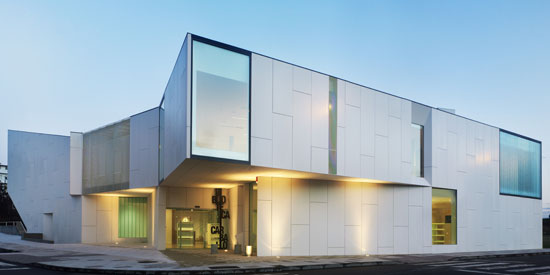
Photo courtesy of TerraCORE Panels, LLC
Porcelain wall panels can be used in larger sizes and offer a different variety of aesthetic appearances than stone.
One of the differences between stone panels and porcelain panels is the larger potential size of porcelain panels which can be manufactured in widths up to 39 inches and lengths that can go up to 118 inches or nearly 10 feet. These larger sizes mean fewer joints, expedited installation, and dramatic design opportunities. From a physical performance standpoint, the porcelain panels exhibit bending strength and water resistance that is better than most stone and ceramic solutions. Its thin size and stable make up also give it very positive thermal expansion coefficients when compared to other building materials. Over the long haul, building owners and maintenance crews will appreciate its resistance to abrasion, stains, chemicals, graffiti, and color changes from sunlight. In all, it is a durable and attractive solution that is on the order of 50% thinner and lighter than standard porcelain products. That means it requires less raw material, less processing and transportation cost, and less impact at the end of its useful life.
Design Applications
Whether faced with stone or porcelain, lightweight reinforced panels are very suitable for a full range of building design applications. In terms of overall performance, it should be recognized that the panels are designed to be somewhat flexible, so they can withstand building movement, seismic racking, and shear forces without damaging the overall panel, the faces, or the building. Due to the use of non-combustible materials, most reinforced stone and porcelain panel products meet or exceed all fire-testing criteria and fire-related code requirements. Honeycomb reinforced panels are similarly tested to resist large missile impacts and hurricane loading and have been found to have up to 60 times the impact strength of 3-cm solid dimensional stone. They are impervious to water penetration, making them suitable for both interior and exterior installations even in wet locations. For example, they have become very popular in hotel bathrooms that seek their durability and water resistance.
Stone and porcelain have been popular choices in high-traffic commercial and institutional buildings where durability has been needed along with great aesthetics. Therefore, any such location can benefit by selecting lightweight honeycomb reinforced panels instead of dimension stone or full thickness porcelain. Hotels, corporate headquarters, banks, retail settings, and car dealerships fit this profile often with the desire to create eye-catching facades that also exude refinement and quality. Public or common areas of condominiums and other multifamily residential buildings also seek the durability of the panels but often welcome the cost-saving benefits. Institutional buildings such as governmental complexes, health care facilities, universities, and churches typically expect to own and operate their buildings for a long time so they are particularly sensitive to the low maintenance, long-lasting qualities of these products. An overall life cycle assessment of lightweight panels will commonly show just how favorable they can be compared to heavier stone or masonry options.
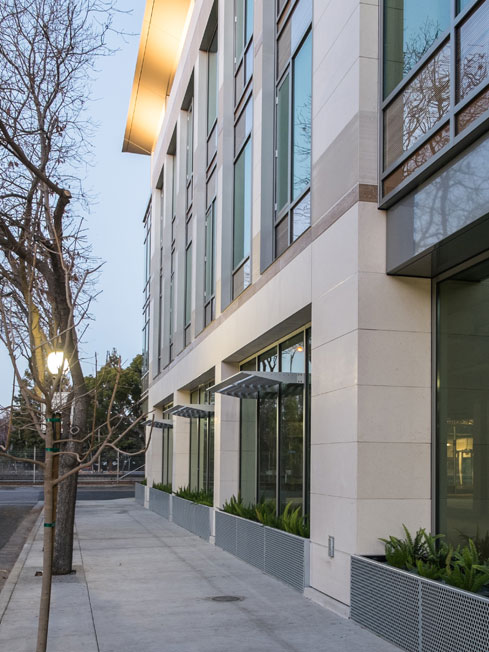
Photo courtesy of TerraCORE Panels, LLC
Lightweight reinforced stone panel systems are appropriate and attractive for use on a wide range of building types.
There are also some other specific design applications where honeycomb reinforced panels can emerge as the preferred choice. In particular, renovation and rehabilitation projects are ideally suited for their use since it is likely that costly structural alterations can be avoided. And the custom sizing capabilities of the panels means that they can be readily fit into almost any existing building of any of the types discussed above. Interior applications make a lot of sense for these reinforced panels too. It is easy to see why they would be popular in high-visibility, high-use interior spaces such as lobbies and gathering places, but they can also be used in a wide variety of other specialty interior applications too such as elevator cabs, restrooms, corridors, etc. In elevator cabs in particular, lightweight reinforced stone panels can be used for new or retrofit construction to save thousands of dollars in mechanical equipment costs, recalibration, and time compared to dimensional stone. Using these panels that are 80% less weight, longer lasting, impact resistant, and can be prefabricated for immediate installation on any wall, floor or ceiling without the use of mortar, often emerges as the right choice.
Rounding out any design application, it should also be noted that complementary detail pieces of stone or porcelain can be used. These include things like smaller in-fill panels on exterior or interior walls. It can also include fabricated detail elements such as soffits, canopies, fascia, cantilevers, cornices, columns, and accent bands. Depending on the design, these details might be made out of the same reinforced panel system or out of separate pieces of stone. Consultation with a manufacturer during the design stages can help identify the best combination of products and choices to create the desired outcomes.
Green Building Contributions
The U.S. Green Building Council (USGBC) has developed the LEED® rating system for green buildings which has been recognized as the leading green building standard in this country. The LEED 2009 system is in place until the year 2015 which overlaps with LEED version 4 introduced late in 2013. Since buildings are currently being designed under both systems, credits available for both are summarized below related to the use of lightweight honeycomb reinforced stone and porcelain panels.
Sustainable Sites
Under LEED 2009, credit SS 7.2 is available for reducing the heat island effect. This is primarily for roofing systems and makes 1 point available. However, many light-colored stone wall panels may meet the criteria to reflect heat and thus reduce the heat island effect. Under an innovation credit, it may be possible to show that the heat reflective qualities are available in the specified wall panels and therefore help reduce environmental heat build-up.
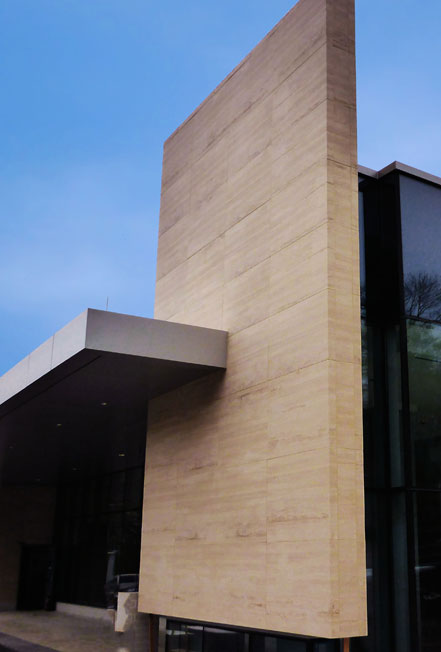
Photo courtesy of TerraCORE Panels, LLC
Using light colored stone panels can help reduce heat island effects when green building design is being pursued.
Optimize Energy Performance
Both LEED 2009 and LEED v. 4 place a strong emphasis on reducing the use of fossil fuels and increasing the use of non-polluting renewable energy. Reflective stone and porcelain products can contribute to improved thermal performance by reflecting away unwanted heat from the building, particularly in warm climates. In order to receive points in this credit category the building must demonstrate a percentage increase in energy savings in accordance with ASHRAE standards. The number of points available depends on the degree of energy savings.
Materials and Resources
This area has changed dramatically between the different versions of the LEED® rating system. LEED 2009 includes four areas where lightweight reinforced wall panels can contribute to an overall green building:
• Credit 1.1: Building Reuse: Maintain 55%, 75% or 95% of Existing Walls, Floors and Roof (1-3 points). If reinforced wall panels already exist in a building being renovated, they may be able to be salvaged and re-used since their life expectancy is very long.
• Credit 2: Construction Waste Management (1 -2 points). The nature of custom fabricated wall panels limits scrap material and reduces construction site waste accordingly.
• Credit 3: Materials Reuse: 5% or 10% (1 or 2 points). When stone or porcelain faced reinforced panels are reclaimed from other installations, they can be re-used in another building and contribute directly to this credit.
• Credit 4: Recycled Content: 10% and 20% (1 – 2 points). The stone and porcelain portion of the panels are most commonly new materials. However, the aluminum honeycomb backer can be made from 100% recycled aluminum and can contribute directly to this credit.
• Credit 5: Regional Materials (1 – 2 points). Many reinforced lightweight wall panels are manufactured in the USA meaning a regional material contribution is possible depending on proximity to the building.
The Materials and Resources category under LEED v. 4 takes a rather different approach to defining the green nature of building products. There are still credits for Building Re-use and Construction Waste Management, but the rest of the approach focuses on the full life cycle of those products. The key documentation needed to demonstrate performance under this approach is referred to as an Environmental Product Declaration (EPD). Individual manufacturers or a trade association can prepare specific or generic EPDs for products. The overall intent is to address an emphasis on transparency in the sourcing, ingredient, and manufacturing processes as called for in LEED v. 4. As we have seen, lightweight reinforced panels can be shown to produce more favorable environmental impacts as assessed throughout the product’s life cycle, including raw material extraction, transportation, manufacturing packaging, use, and disposal at the end of a building’s useful life.
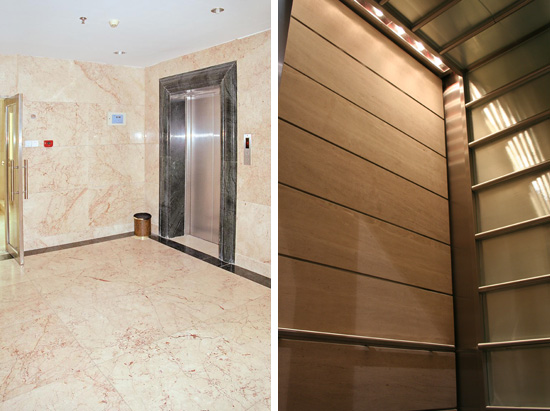
Photos courtesy of TerraCORE Panels, LLC
Lightweight stone panels can be shown to have favorable life cycle results as demonstrated in Environmental Product Declarations (EPDs) and preferable indoor environmental performance as shown in Health Product Declarations (HPDs).
One of the numerous methods to track the environmental benefits of a product is a program called GreenWizard which is a new software system that allows users to manage the selection of green materials and the workflow for green rating systems. This includes tracking materials and their application to LEED® credits. Materials in the searchable database are collected from manufacturers who provide product data, supplier information, and documentation that enables product transparency when comparing materials for green attributes. Individuals who want to search the database for information on a product can do so by subscribing to a free registration. GreenWizard is also a repository for EDPs as well as Health Product Declarations (HPDs). The Health Product Declaration Collaborative created and supports the HPDs as an impartial tool for the accurate reporting of product contents and each ingredient’s relationship to the bigger picture of human and ecological health. The HPD objectively defines the critical information needed to support accurate supply chain disclosure by manufacturers and suppliers, and informed decisions by building designers, specifiers, owners, and users.
Specifying Lightweight Honeycomb Reinforced Stone Wall Panels
When specifying lightweight reinforced wall panels, there are choices and specification details to pay attention to. Coordination with manufacturers during the design phases of a project will help gain insight into details, cost drivers, installation requirements, and fabrication lead times. Some of the relevant items to address in a standard 3-part specification format are highlighted as follows.
Part 1 - General
Quality assurance is often addressed by citing specific national testing and standards for products. In the case of lightweight reinforced wall panels, there are three that are particularly relevant:
• ASTM C880 - Standard Test Method for Flexural Strength of Dimension Stone. This will be relevant to any stone products selected or specified.
• ASTM B221 - Standard Specification for Aluminum-Alloy Extruded Bars, Rods, Wires, Shapes and Tubes. This test will be relevant to the aluminum honeycomb backing when used on a reinforced panel.
• ASTM D897 - Standard Test Method for Tensile Properties of Adhesive Bonds which will apply to epoxy or other adhesives used in the fabrication of the panels.
Beyond that, exterior panels should be tested for all of the usual things expected in an exterior cladding system such as air leakage, structural performance, water penetration, and wind resistance. Interior panels should be tested for surface burning characteristics and rated accordingly.
Other general specification information includes the appropriate request for submittals and shop drawings that confirm that the correct wall panels are being ordered and fabricated. It is also reasonable to request experienced installers be used with a minimum of 3 years relevant experience and approval by the panel manufacturer. Further a full warranty should be called for and submitted that demonstrates coverage for at least a 10-year coverage against delamination and separation of panel components.
Part 2 - Products
Identifying the specific lightweight reinforced wall panel products that are desired requires covering several items. If multiple product types are selected for a building, then obviously they each need to be specified and their locations identified on the drawings.
• Panel type, thickness, and size: The particular type of panel needs to be selected such as natural stone or porcelain bonded to a particular type of reinforcing or core. The thicknesses of the exposed surface needs to be called out as does the thickness of the honeycomb core, other intermediate backing sheets, and the overall thickness of the fabricated panel. Sizes of the panels are generally shown on the drawings, but parameters for minimum and maximum sizes can be addressed in the specifications.
• Stone type and finish: Fundamental to the panel appearance is the choice of stone or porcelain being used. The choice should be influenced based on interior or exterior usage and the overall design properties being sought. The specific finish of the stone should also be called out from available options of polished, honed, flamed, antiqued, sandblasted, acid washed, or bush-hammered.
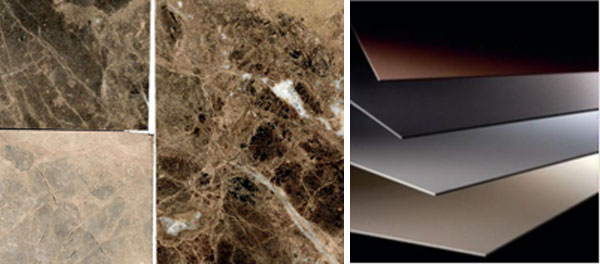
Photo courtesy of TerraCORE Panels, LLC
The particular type, thickness, and finish of stone (shown on left) or porcelain (on right) needs to be specified for individual design projects as selected from a range of choices.
• Aluminum honeycomb: The type of aluminum alloy and information related to the aluminum portions of the panel should be identified. The size of the cell and the thickness of the cell walls, along with the top and bottom details can also be specified based on manufacturing options. Note that the inherent strength of the honeycomb is based on the thickness and configuration of the aluminum.
• Adhesives – Epoxy is the common adhesive to bond the facing panel to the honeycomb core. All adhesives must meet code and testing requirements.
• Attachments: Concealed fastening is most often used and will thus dictate the specific attachment methods consistent with the manufacturer’s system. As such, it should be specified to be provided by the same company that provides the panels as a complete, integrated system.
• Accessories: Fasteners and joint sealers may be recommended by the manufacturer but need to be addressed to be sure they are appropriately suited to the particular building application.
• Fabrication: Details of fabrication such as system installation, joint details, and sealer application (or not) should all be called out as appropriate.
Since some aspects of products vary between manufacturers, using the specification items above will aid in product-to-product comparisons during design and assure appropriate installations during construction.
Part 3 - Execution
Installing pre-fabricated wall panels is fairly straightforward but requires appropriate attention to detail to assure the desired outcome is achieved. It is important to note that stone is a natural material with part of its beauty and appeal coming from variations and irregularities in the surface and appearance. Everyone involved should expect this variation within the normal range of tolerances for any given stone type.
• Examination and Preparation: The rest of the exterior wall assembly needs to be in place with the requisite air and water barrier already installed. This should all be inspected for completeness and conformance with the building design and adequacy for correct attachments before the wall panels are installed.
• Installation and Field Quality Control: Since it is the installation of the fastening system that can determine if the panels end up appropriately aligned, level, and plumb, special attention should be paid to aligning clips or channels properly. Installers should definitely follow manufacturers’ instructions and approved shop drawings and comply with allowable tolerances.
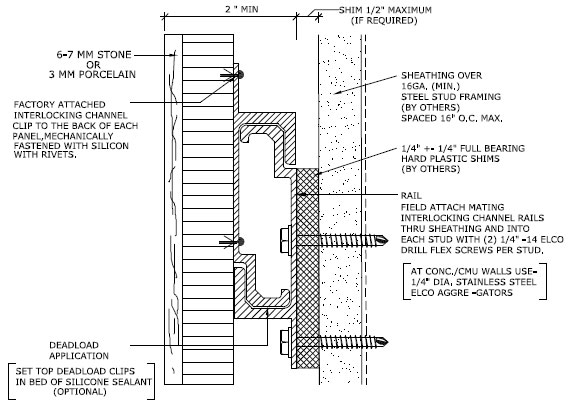
Image courtesy of TerraCORE Panels, LLC
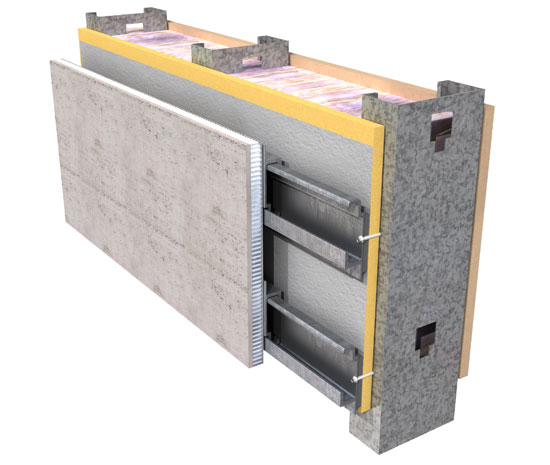
Photo courtesy of TerraCORE Panels, LLC
Installation systems for panels may vary and should be coordinated with manufacturers to be sure that field quality control is maintained.
• Repairs: As a natural material, it is not uncommon for chips or gouges to occur either in shipping or installation. Small chips, scratches, etc. can usually be smoothed out with a diamond file, buffer, or sandpaper. For large areas, a two-part non-yellowing stone epoxy can be mixed with a bit of tint to match and a little stone dust from a scrap panel. Apply into the damaged area and clean and smooth with a putty knife. If the stone has natural markings, a permanent marker can add in a little accenting to prevent the repair from standing out. This procedure normally makes repairs virtually invisible.
• Joint sealer: Where joint sealer is used or required, it should be specified in the appropriate specification section consistent with good sealing practices, code compliance, and manufacturers’ recommendations.
• Cleaning and Protection: The nature of most panel finishes is to be fairly smooth and easy to clean. In most cases, dust and dirt from construction can be easily wiped clean with a soft cloth or rinsed with water.
Conclusion
Lightweight reinforced stone and porcelain panels provide an attractive design solution to creating elegant, durable, cost-effective, and sustainable wall systems in a variety of building applications. As an interior design solution, the lightweight materials mean easier and less costly installations while employing real, natural materials instead of a “look alike.” New high-strength porcelain allows an even greater range of aesthetics and can be installed in larger panels for additional character statements. When used as an exterior material, the benefits of using lightweight reinforced stone and porcelain panels include strength, flexibility, and demonstrated compliance with seismic, wind, and other loading codes for most locations. Providing the aesthetics of traditional stone, architects can now specify manufactured products that maximize current technology to create dramatic and long-lasting buildings.
 |
TerraCORE Panels provides exterior and interior natural stone and large-format porcelain on lightweight honeycomb-backed panels. TerraCORE Panels are environmentally friendly, easier to install and more sustainable than traditional stone. TerraCORE, along with its partner Techlam® by Levantina, offer the highest quality in stone and large-format porcelain for exterior use. www.TerraCOREpanels.com. |



